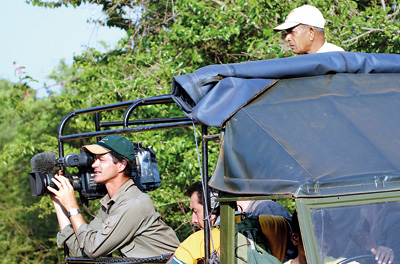Boosting Sri Lanka’s brand image
View(s):Gehan de Silva Wijeyeratne argues that the difficult process to obtain wildlife film permits from the DWLC and the FD are unintentionally hostile to the country
The ability for Sri Lanka to build a positive brand image overseas is being severely undermined by misguided policies which require professional film crews to acquire film permits to film in the national parks and reserves. This article explains why this requirement needs to be abolished immediately for professional film crews who do not require special privileges above that of a normal visitor.

A film crew in the Yala National Park. Pic by Gehan de Silva Wijeyeratne
On November 13, 2012, text messages pinged in like the sonar beam of a hunting Sperm Whale as people alerted me to a broadcast on BBC’s Newsnight programme. It was a critical report on the UN failing civilians in Sri Lanka. My first email was to a senior official at the Department of Wildlife Conservation (DWLC). I reminded him of a conversation we had in September 2012 on the need to remove obstacles to the outflow of positive stories on Sri Lanka from its wildlife. This will help counterbalance the negative publicity on issues related to the now concluded war against the Tamil Tigers.
The imposition of film permits by state agencies such as the DWLC and the Forest Department (FD) impedes the natural flow of positive publicity for Sri Lanka. By not counter-balancing negative publicity it results in a weakened brand image which makes it harder to attract Foreign Direct Investment. The brand image of Sri Lanka should not be compromised so that a government department can show a few thousand dollars of film permit revenues in a penny wise but nationally pound foolish strategy.
There has also been debate on the reasonableness of the fee structure imposed by the DWLC on film permits for professional film crews. Sadly, to debate the level of fees or to peg it at comparable rates levied in some other countries, is to miss the point altogether. Sri Lanka needs every avenue for positive publicity to be kept wide open, not closed. Nor does it need a handful of dollars in film permit receipts at the expense of squandering the opportunity for millions of dollars of free positive publicity.
Let me explain with a simple example why the mere requirement for a film permit, irrespective of the level of the fee, obstructs publicity. Let’s assume a crew making a general travel documentary have arrived in Sri Lanka to document new hotels and perhaps the infrastructure development in the South followed by filming in the Habarana-Sigiriya area and featuring some of the hotels in that area. On checking in to their hotel in the South, it should be possible for a hotel General Manager (GM), naturalist or any member of staff to suggest a short trip to Yala National Park to shoot some footage of wildlife to use alongside their travel documentary. Similarly, in Habarana they should be able to act impulsively on a suggestion to spend an hour or so to film the Elephant Gathering at Minneriya or Kaudulla National Parks. Sadly, at neither location can they take advantage of such suggestions because it is unlikely that they would have undertaken the currently onerous procedures to obtain film permits in advance. It does not matter if the film permit is USD 5 or USD 500 a day. The requirement to obtain a permit means the loss of opportunistic filming at national parks by professional film crews.
A considerable amount of time and energy is required to obtain film permits in advance with forms having to be filled, details of the film crew, script, exact dates, etc and multiple visits to the department concerned. This means even if the companies hosting a film crew were aware well in advance of the arrival of a film crew, the hotel (or their office in Colombo) would rather take them to a local craft shop than burden itself with the responsibility to obtain film permits. It requires a significant amount of work to facilitate a film crew to have a few hours in a national park to show off the best of Sri Lanka. Furthermore, for a general travel film crew from overseas, it is simply not worth their time to engage in so much dialogue to spend a few hours in a national park or reserve to widen the scope of their footage. Even locally based correspondents who can film for agencies abroad will find it easier to interview on film a human rights campaigner than a leopard.
Unlike dedicated natural history film crews, most film crews do not require special privileges or great lengths of time and will in most cases be happy to film from their vehicle just as any other visitor. So why does Sri Lanka make it almost impossible (in terms of the practical logistics) for a film crew to spend a few hours in a park and feature what Sri Lanka has to offer?
There is another aspect about the requirement for film permits which does not make sense. The international publicity generated helps the country’s brand image, helps to attract foreign direct investment, generates tourism revenues, creates employment and produces revenues from gate receipts at the national parks. Normally, the beneficiary would pay those who generate such publicity. If therefore the DWLC and FD had a policy that certain film crews would be eligible to be paid a fee by them, it would seem reasonable. Instead we have the DWLC and FD demanding a fee for their parks and reserves and for the country to be given publicity. This is not logical in the current context where Sri Lanka needs to maximise positive publicity in the international arena. Demanding a fee could be justified if the DWLC were to confer special privileges such as allowing the crew to use specially built wildlife filming hides, allowing them to film at night, making available expert staff etc for a specialist film crew. But then again the question should be raised, why charge money for this and should it not be a part of a government department’s commitments to the nation to facilitate film crews and raise the profile of Sri Lanka?
Whichever way one looks at it, it simply does not make sense to go down the road of imposing film permits on every film crew. Especially if this means that a significant obstacle is imposed on everyone from staff at park-adjacent hotels, any public spirited citizen to the Sri Lanka Tourism Promotion Bureau, to generate positive publicity for Sri Lanka. The 2013 budget of the Government of Sri Lanka allocates money for the Sri Lanka Tourism Promotion Bureau to purchase air tickets for foreign media. The 2013 budget speech also states that the government expects the tourism industry to host these journalists. It makes no sense to fly down foreign media, have them hosted at local hotels and then not give them easy access into the parks.
At a time when the country needs every bit of positive publicity it can get, it is severely counter-productive to make it impossible to take advantage of Sri Lanka’s greatest media asset. The DWLC and the FD need to realise that they control access to the most consistent and reliable media tool that Sri Lanka possesses. Wildlife as a media tool is more important than cricket. The latter is viewed only in a relatively few countries. Furthermore, international air time on cricket does not necessarily mean that a viewer is imbued with a positive feeling for a country. Wildlife on the other hand is universal and people all over the world watch wildlife and travel documentaries and are inspired to travel to the featured destinations.
For the World Travel Market (WTM) in November 2012, I prepared three media briefs which explained why Sri Lanka has a strong claim to being the best all round wildlife destination in the world. A full length article was subsequently published in the Sunday Times on January 13, 2013. No other country has its combination of terrestrial big game, marine wildlife (especially Blue Whales and Sperm Whales), endemic bio-diversity, landscapes and affordable tourism infrastructure in a compact landscape. It is the best for big game safaris outside Africa. It has the largest annually recurring concentration of wild elephants in the world, is the best in the world for Blue Whale, is the best for super-pods of Sperm Whales on a commercial whale watch, is best in the world for leopard and Sloth Bear, best chance for a Sperm and Blue Whale on the same sailing, a hot spot for reptiles, the largest bird wave in the world, and the list goes on. In November 2012, in the UK, British Airways used an image of a leopard in its advertisements, to advertise its flights to Sri Lanka. It demonstrates how much has been achieved to associate the island with its wildlife.
It would be a tragedy if potentially Sri Lanka’s greatest media asset is squandered for misguided and hugely obstructive polices which require film permits. If the DWLC and FD wish to have a film permit policy it should be to set a policy on the following lines. Firstly, to leverage wildlife to gain the maximum positive international media coverage for Sri Lanka. Secondly, to have an agenda to be the most media friendly state conservation agencies in the world. Thirdly, to enable the first two objectives, to remove the requirement for any film permit by professional media crews who do not require special privileges for filming terrestrial wildlife. Filming from boats for marine wildlife should have the same exemption. [However, I note that in-water filming of marine mammals will require regulatory oversight to ensure adherence to international guidelines].
Although I have focussed on the DWLC and FD, the same criticisms apply to the Central Cultural Fund (CCF), the Department of Archaeology and other state agencies who may with the best of intentions unintentionally impede positive publicity. There are also other issues to be addressed such as removing (again) the requirement for someone from the National Film Corporation to accompany all film crews.Badly designed and damaging policies on film permits are legacy policies which have unintentionally done well to serve the enemies of the country. The private sector has also so far failed to recognise sufficiently the damage and lobby successfully for their removal. The current requirements for film permits for professional film crews by the DWLC and FD are unintentional obstacles to building a positive brand image of Sri Lanka. It is time to remove them.
Follow @timesonlinelk
comments powered by Disqus



















